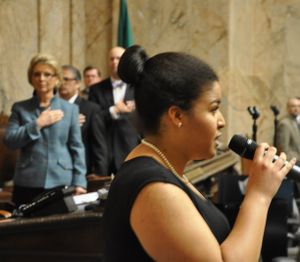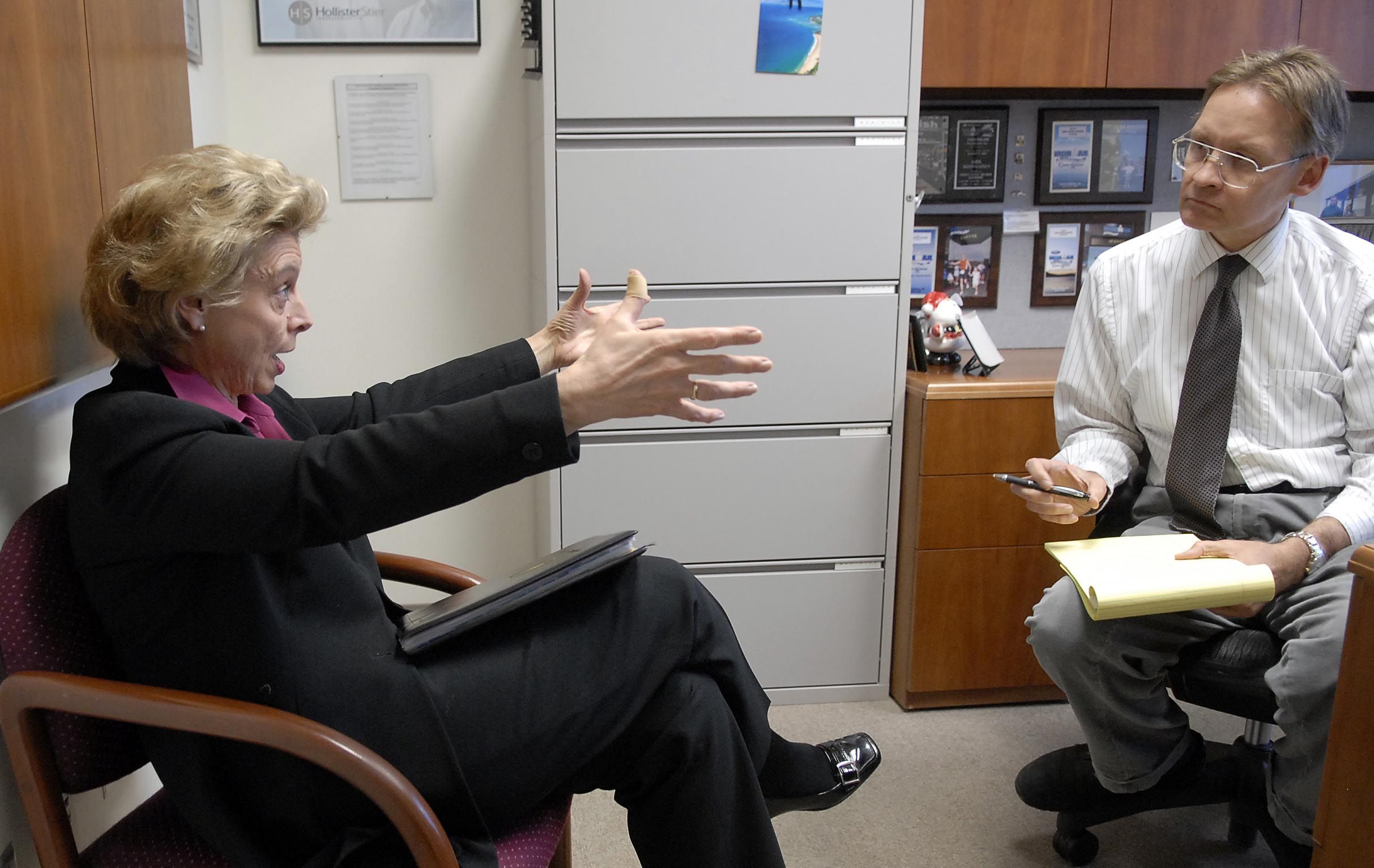State of the State: The full speech, and rebuttal
Sofia Smith of Seattle sings the National Anthem to a joint session of the Legislature before Gov. Chris Gregoire's State of the State speech.
OLYMPIA -- By reading the posts below, you can get the highlights of Gov. Chris Gregoire's State of the State speech from Tuesday morning.
If you want the full speech, click on the PDF attachment.
For the Republican rebuttal, delivered by Sen. Joe Zarelli of Ridgefield, click here to go inside the blog.
Hello. I’m Joe Zarelli, budget leader for the Senate Republicans in Olympia.
Thanks for the opportunity to speak with you about issues that are critically important to our state.
Today the governor made her final address to the Legislature.
Before I respond to some of what she said, I want to wish Governor Gregoire well during her final year as governor of our state.
She has served the people of Washington with distinction for many years.
And she deserves our thanks as she and her family move toward a new phase of their lives.
Not surprisingly, the governor and those of us on the other side of the aisle haven’t always seen eye-to-eye.
But the respect we have for each other has allowed us to work together, and I fully expect that will continue this session.
I don’t think there is any doubt that the budget situation is the Legislature’s top priority.
Closing a gap that is now about 1 ½ billion dollars will require some difficult choices.
But as the saying goes, “it is what it is.”
To me, the Legislature is at a fork in the road.
We can go for a short-term fix that is based on new – and in some cases, temporary – revenue.
Or we can seize opportunities that will help make state government more efficient, cost-effective and sustainable now and for years to come.
There will be disagreements about which direction to go.
But fortunately, our Legislature is not like Congress.
We are all Washingtonians.
You may recall how Democrats and Republicans in the Senate worked together like never before on the budget that was adopted this past year.
That spirit of cooperation and trust is still alive, and I expect it will help to see us through the next couple of months.
There are two sides to the budget equation.
They’re the same two sides you know from your household or business.
One side is revenue, or income; the other is spending.
Let’s take an honest look at those.
Some will point out that revenue from taxes and other sources is continuing to grow, at a rate of almost 7 percent.
That’s true.
But don’t take that to mean the state is rolling in money.
While the rate of revenue growth is about average, the level of revenue coming in is about where it was six years ago.
Over on the spending side, some would have you believe that state government has cut spending by 10 ½ billion dollars in the last three years.
The reality is, actual spending is down less than 2 billion dollars from the peak spending level before the recession.
That’s a far cry from the 10 ½ billion some are claiming, which were only reductions in anticipated spending.
I trust you to handle the truth about the state’s finances, so here’s the bottom line.
Revenue is about where it was six years ago.
The population of our state and demand for state services is up from six years ago.
Combine that with the drop in anticipated revenue we saw this past year, and the result is a very difficult budget situation.
But do not be misled by claims that government has "cut to the bone".
Government can become more efficient and cost-effective, if the Legislature wants it to.
What can the Legislature do to stretch the revenue level of several years ago to meet the needs of today?
Here’s how I would approach it.
First, we prioritize – or reprioritize.
Think of the budget as a box that is based on the existing level of revenue.
We build the budget by putting the highest-priority items in the box first…
…things like education, and public safety, and services for the most vulnerable.
When all the existing revenue is appropriated, we close the box.
The things left outside the box may be priorities, but they’re lower priorities…
…the things that are nice to do, but are not things government must do.
Second, we look at reforms.
For instance, we look at how tax dollars are being spent and ask whether we can stretch them.
If so, we might be able to put more things in the budget box.
Reforms can and should look at both spending and tax policy.
But reforms are not strictly about dollars and cents.
Reforms are simply the things that will result in a better, smarter, and more effective state government.
A reform may be about improving outcomes more than saving money.
A reform may result in benefits now or a few years from now.
A reform might mean the state gets out of an activity entirely…or changes how it delivers services.
Let me share some examples of the reforms we should be considering in the next two months.
Our state spends 2 billion dollars in the current budget just to service the amount of debt we carry.
We should ask the people of our state to amend the constitution and lower the permissible level of debt.
Over time, that would free up hundreds of millions of dollars for other priorities.
Health care consumes a huge amount of taxpayer dollars.
And there’s only so much we can do about the costs of publicly funded health care, due to federal rules.
But we could look at adjustments in co-pays and premiums and eligibility for those who are getting public subsidies.
I think we should consider that, before anyone suggests cutting services to developmentally disabled people.
Our K-12 education system, which accounts for a majority of spending, also offers opportunities for reform.
Some reforms would save money.
I’ve suggested a way to shift the burden of K-12 funding to the state.
That would take the pressure off local school levies.
And it would help in responding to the Supreme Court’s recent ruling about education funding.
There are already discussions under way between Democrats and Republicans about that.
Other reforms would lead to better outcomes for our students.
We all recognize how much influence teachers have on student achievement, and the importance of having a great teacher in every classroom.
Senator Steve Litzow and Senator Rodney Tom are working across the aisle and making significant progress on policies that would promote and support teacher excellence.
There’s a reform that combines K-12 and health-care.
If the Legislature made it possible for Washington schoolteachers to purchase their health-care benefits at a statewide level, as state employees already can, it would help on two levels.
Many teachers would see huge savings in their household budgets, and their school districts would free up money that could go into classrooms instead.
Senator Steve Hobbs is helping lead the way on that reform.
Part of our solution to the budget situation would require both parties to take aim at the “sacred cows”' of government.
For my friends on the Democrat side of the aisle, that means having the courage and conviction to look at several ideas that are normally unpalatable to them.
For instance:
--Whether the state can continue to fund social services for non-citizens at almost 200 million dollars a biennium.
--Whether the state can continue to spend 150 million dollars a biennium -- which is more than we spend on state parks – due to lawsuit abuse.
--Whether new public employees should be enrolled in a pension system more like that which we see in the private sector.
This would allow employees to have more portability and control, while taxpayers would see more certainty and stability when it comes to costs.
--Whether the Legislature should have more tools available to it in an economic crisis.
For example, public employee compensation accounts for a huge part of spending, but it’s one of the few areas that is likely to go unchanged during budget discussions.
That’s because the Legislature isn’t allowed to amend labor agreements on its own, even at times like this.
I’d also like to see the Legislature make good on its promise of 10 years ago to farm out government projects where the private sector can do them more efficiently.
As I ask my Democrat colleagues to look at those items, likewise my Republican colleagues must be willing to look at tax policy reforms.
Just as we know there is room for improvement on the spending side of the equation, let’s acknowledge that our tax code is imperfect as well.
We must be willing to examine how it can be improved from a policy perspective.
Let me be clear: I oppose the governor's proposal to increase the state sales tax by a half-billion dollars.
Partly because it is a temporary fix that does nothing to improve our budget's sustainability…
…but also because there are other places to reform our tax code…
…changes that would not force everyone to pay more.
To that end,
I have suggested that the Legislature dial back some of the preferential tax rates for certain industries…
…and use a portion of the resulting revenue to address the competitive disadvantage faced by new businesses because of our business and occupation tax.
This proposal would benefit more than 90,000 businesses over four years.
It would also address a core failing of our current tax policy – namely, the competitive burden the B&O tax puts on start-up businesses in the state.
That can only help to stimulate the private-sector job growth our state needs...
…the sort of job growth that raises consumer confidence…
…and ultimately generates more revenue through the existing tax structure.
The governor and others are pointing to reforms that have been made in the past few years.
Some of them, such as the agency consolidation effort spearheaded by Senator Michael Baumgartner this past year, have already produced savings.
But in my mind the Legislature has barely scratched the surface when it comes to reforms.
Afterwe make sure existing dollars are dedicated to the highest-priority items…
…and after we look at adopting reforms.
…the next step, if necessary, is to look at revenue options.
Not because it’s good policy in and of itself…
…but because it’s better than the alternative, which is to make cuts to the core priorities of government.
Having said that, I am convinced that if we go through the first two steps -- prioritize and reform -- we will not need to reach the third step.
Finally, underlying all of these budget decisions should be the notion of sustainability.
I've had friends from both sides of the aisle, from Senator Andy Hill to Senator Jim Kastama, voice to me their fervent belief -- which I share -- that our focus must be on changes that put the budget on a sustainable course.
In closing, let me say again that we recognize there are difficult choices ahead.
But as the proverb goes, “In Crisis, There is Opportunity.”
The 2012 Legislature has the opportunity to reform government and make it more sustainable…
…to give you a government that has its priorities straight and doesn’t waste your money.
And we will work in a cooperative way to move our state forward.
Thank you for watching.

